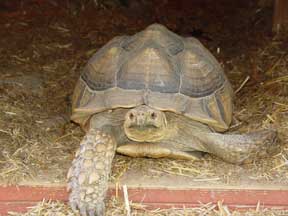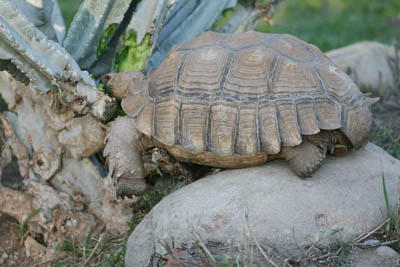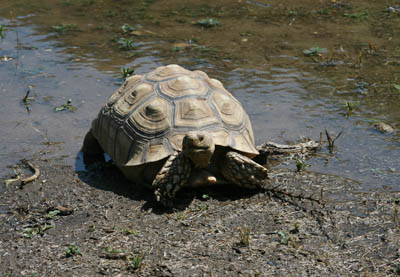
About the Ojai Sulcata Project
My wife Maree and I first saw a pair of sulcatas, in about 1985 at the home of Max and Lillian Greene in Meiners Oaks, CA. So began an adventure that we still enjoy today. Early 1986, we purchased a pair of sulcata tortoises. Yes, purchased! 25 years ago there were no rescues full of sulcatas. We found a breeder, made the contact, and brought the pair home to Ventura, CA. So it began.
No, we did not allow them to breed. Soon they grew too large for our small residential back yard. What to do? I heard about some research on sulcata tortoises at the San Diego Zoo. I called them, and yes, they were interested and would adopt our 80-pound babies. May 16, 1999 we made the trip to San Diego, about a two-hour trip. I am here to tell you a couple of hours with two big sulcatas was a bit odorific!!
We were told their diet had been pumpkin and alfalfa, but they actually preferred the Bermuda grass, rose petals and hibiscus flowers. Therein lies the reason for this web site: logical, common sense captive care of the sulcata tortoise. After all these years there is still a lot of discussion about diet and captive care. There are other web sites dedicated to sulcata tortoise care, some with good information, and some, I have observed, with outdated or inaccurate information.
While perusing various web sites and reading e-mails I have received, I found that there are a large number of sick sulcata tortoises needing veterinary care. These animals are being forced to live in unnatural conditions and climates. The result of this unnatural care is too many sick tortoises. Sulcata tortoises, even young ones, are very adaptable and hardy reptiles, somewhat like having a miniature Sherman Tank in your backyard. In 25 years I have only lost five tortoises, all of which were too far along in their illnesses to recover.
 We must remember that these reptiles, the largest mainland tortoises, have survived many climate and habitat changes over the eons. They still survive in diverse climates across their native Africa, hot and arid with scarce food, areas that get cold, savannas with plenty of food, and areas with high humidity. The sulcata tortoises we enjoy today are many generations removed from their "wild caught" ancestors and are still being subjected to difficult environments. I care for two wild-caught females. See housing for their story.
We must remember that these reptiles, the largest mainland tortoises, have survived many climate and habitat changes over the eons. They still survive in diverse climates across their native Africa, hot and arid with scarce food, areas that get cold, savannas with plenty of food, and areas with high humidity. The sulcata tortoises we enjoy today are many generations removed from their "wild caught" ancestors and are still being subjected to difficult environments. I care for two wild-caught females. See housing for their story.

I do not know how many sulcata tortoises I have rescued and rehomed over the years. Currently my rescue facility is full, with over seventy tortoises of all sizes and ages, from juveniles to two-hundred pounders. My wife and I now own twelve acres, so we have the room to expand. That takes a lot of money, and we are now seeking donations to fund the expansion of our Project. All the sulcata tortoise rescues I am aware of are filled to capacity. I much prefer to provide a permanent home as opposed to sending them in to more environmental stress.
Dr. Gerald Kuchling, a world-renowned turtle and tortoise expert, was visiting southern California in 2011, and he stopped in to see our sulcata setup. He left this comment in our guest book: "The next best place for Sulcata after Africa." 28 April, 2011; signed, Gerald Kuchling.
This web site is dedicated to sharing what I have observed and learned from the animals themselves. My Ozark-raised grandfather, once told me,"Grandson, pay attention to Mother Nature and she will teach you all you need to know about the earth." These grand old living fossils have taught me a lot about their needs. I am not an expert or a veterinarian, but I do have over twenty-five years of hands-on care experience with sulcata tortoises.
We may never have exact care criteria. However, we can change a few things to improve our captive care habits. I suggest that you keep an open mind, and read what I have to share. Quite possibly, something on our web site will benefit you and, more importantly, your animals.
It is my great desire that we keep learning and mutually share our acquired knowledge, so these awesome creatures will grow as they were intended to, living in harmony with nature, not living as caged pets.

